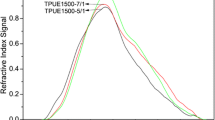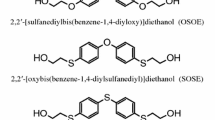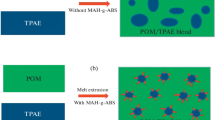Abstract
A series of main-chain-fluorinated thermoplastic polyurethane elastomers (FTPU) based on fluoropoly(oxyalky1ene)diol (FPOA) were prepared by a one-step bulk polymerization. Polybutylene adipate (PBA) was combined with FPOA as a soft-segment in order to improve the solvent solubility of FTPU. The effects of the mass ratio of FPOA/PBA and the mass fraction of hard-segment on the mechanical properties of FTPU were investigated. The structure and morphology of FTPU were characterized by FTIR, GPC, DMA, surface property, and AFM analysis. The results indicated that the tensile strength and elongation at break for the sample of FTPU with FPOA/PBA ratio 30/70 can reach as high as 36.6 MPa and 1228.1%, respectively. It exhibited relatively high molecular weight, high damping property, enhanced thermal stability, and extremely low surface tension. The introduction of fluorinated blocks made the extent of incompatibility of the two phases of FTPU greater and the trend of micro-phase separation more serious.










Similar content being viewed by others
References
Li S, Liu Y (2002) Polyurethane resin and application. Chemical Engineering Publisher, Beijing
Frick A, Rochman A (2004) Characterization of TPU-elastomers by thermal analysis (DSC). Polym Test 23(4):413–417
Rogulska M, Podkoscielny W, Kultys A, Pikus S, Pozdzik E (2006) Studies on thermoplastic polyurethanes based on new diphenylethane-derivative diols. 1. Synthesis and characterization of nonsegmented polyurethanes from HDI and MDI. Eur Polym J 42(8):1786–1797
Yeganeh H, Barikani M, Khodabadi FN (2000) Synthesis and properties of novel thermoplastic poly(urethane-imide)s. Eur Polym J 36(10):2207–2211
Cao Q, Li Y, Jing B, Liu PS (2006) Structure and mechanical properties of thermoplastic polyurethane, based an hyperbranched polyesters. J Appl Polym Sci 102(6):5266–5273
Tonelli C, Ajroldi G (2003) New fluoro-modified thermoplastic polyurethanes. J Appl Polym Sci 87(14):2279–2294
Hung MH, Farnham WB, Feiring AE, Rozen S (1993) A new synthetic approach to poly- and perfluorinated polyethers. J Am Chem Soc 115(20):8954–8959
Yoon SC, Sung YK, Ratner BD (1990) Surface and bulk structure of segmented poly(ether urethanes) with perfluoro chain extenders. 4. Role of hydrogen bonding on thermal transitions. Macromolecules 23(20):4351–4356
Tonelli C, Trombetta T, Scicchitano M, Simeone G, Ajroldi G (1996) New fluorinated thermoplastic elastomers. J Appl Polym Sci 59(2):311–327
Guelcher SA, Gallagher KM, Didier JE, Klinedinst DB, Doctor JS, Goldstein AS, Wilkes GL, Beckman EJ, Hollinger JO (2005) Synthesis of biocompatible segmented polyurethanes from aliphatic diisocyanates and diurea diol chain extenders. Acta Biomater 1(4):471–484
Oertel G (1989) Polyurethane handbook. Hanser Publishers, Munich
Kwok DY, Neumann AW (2000) Characterization of the surface free energy of cellulose ether films. Colloids Surf A 161(1):31–48
Sharma PK, Hanumantha RK (2002) Analysis of different approaches for evaluation of surface energy of microbial cells by contact angle goniometry. Adv Colloids Interface Sci 98(1):341–463
Sikka M, Singh N, Karim A, Bates FS (1993) Entropy-driven surface segregation in block copolymer melts. Physical Review Letters 3(70):307–310
Mclean S, Scott S, Bryan B (1997) Tapping-mode AFM studies using phase detection for resolution of nanophases in segmented polyurethane and other block copolymer. Macromolecules 30(26):8314–8317
Reifer D, Windeit R, Kumpf RJ (1995) AFM and TEM investigations of polypropylene/polyurethane blends. Thin Solid Films 264(2):148–152
Acknowledgment
This study was supported by Natural Science Fund of China (10676024).
Author information
Authors and Affiliations
Corresponding author
Rights and permissions
About this article
Cite this article
Liu, P., Ye, L., Liu, Y. et al. Preparation and properties of the main-chain-fluorinated thermoplastic polyurethane elastomer. Polym. Bull. 66, 503–515 (2011). https://doi.org/10.1007/s00289-010-0352-4
Received:
Revised:
Accepted:
Published:
Issue Date:
DOI: https://doi.org/10.1007/s00289-010-0352-4




